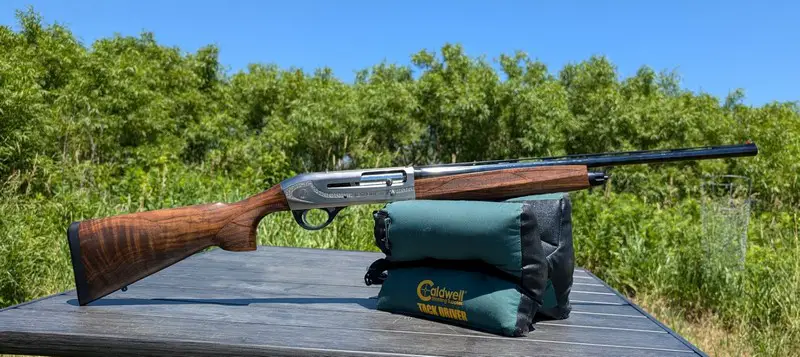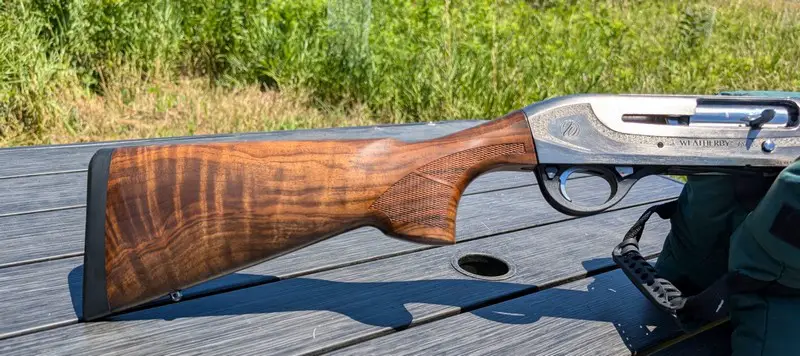|
Weatherby 18i Deluxe 20 Gauge: A Big Winner  I've tested and used various Bruno Civolani action (a.k.a inertia) shotguns going back to the H&K imported pre-Beretta Benelli's. It is actually quite a story, for back in the 1960's all of the major gun manufacturers loudly rejected Bruno Civolani's patented action, a “Gun with a Floating Breech Bolt” US3447417A. This patent was filed February 27, 1967. Granted in 1969, the current status is expired since 1986. The Bruno Civolani action has become the dominate hunting shotgun action of the day and has largely driven the pump gun into oblivion. The hunting shotgun market has experienced nothing like this since the John M. Browning Automatic-Five. Although sold at a large premium by the now-defunct Benelli Brothers and by the Beretta-owned version of Benelli, with the expiration of the patents that is no longer the case. In vivid contrast to the extensive machining required to make an Automatic-Five, the Civolani-based self-loader is extremely cheap to make. Steel receivers are not required or desired, there are no action bars, no gas ports, no gas pistons, and so on. Though not offering the integral recoil reduction of around thirty percent built-in to gas actions, the entire gun is essentially built upon a split bolt and two springs. You might think that inertia guns were perfected by now over 55 years later, but that has clearly not been the case. Synonymous with the proliferation of the Benelli brand has come the well-known maladies of the “Benelli Click” and the “Benelli Thumb.” With the introduction of the Beretta-owned Benelli SBE3, guns that don't shoot anywhere near where they are pointed has been a nasty trick that Benelli has no interest in fixing. The same is true to a degree with the Benelli Ethos. The definition of an enjoyable semi-auto has not changed in my lifetime. A good semi-auto prints patterns where it is pointed, has a decent trigger, a decent safety, and is reasonably easy to load and unload. Refinement of the basics has eluded countless shotguns, quite sadly. The consumer naturally bares some responsibility as well, for the worship of cheapness has had unsavory consequences. Better shotguns require more closely monitored tooling, higher scrap rates, and independent proof testing. Shotguns have lousy triggers only because they are not checked, they don't shoot to point of aim because they are not checked, and they are hard to load because they are not checked. All of this quality control naturally has a cost, a cost American consumers have shown an unwillingness to share. The Weatherby 18i is made by the well-established Italian firm of Marocchi, now renamed C. D. Europe SRL. Marocchi has been around since 1922, when Stefano Marocchi founded it. The Marocchi family still operates the business, currently led by Mauro Marocchi. The Weatherby 18i is apparently the first Weatherby shotgun to be engraved Sheridan, Wyoming on the receiver. Weatherby has been open in Wyoming since 2019 and they are growing. The Weatherby 18i Deluxe 20 gauge has an MSRP of $1899, with a street price of around $1299 or so. The 18i line has numerous models, including 3 and 3-1/2 inch 12 gauges that can be had for below a thousand dollars. The 18i was the platform upon which the newest Weatherby shotgun, the Sorix, is based. I originally had a bit of reticence about testing this 18i Deluxe 20 gauge, as the Sorix 20 gauge, already out in 12 gauge, is coming soon. A quick look at the 18i gave me a few misgivings about what looked like a smallish safety and a less than generous recoil pad. I'm quite delighted to tell you that my initial thoughts were quite wrong.
 The Weatherby 18i Deluxe 20 gauge 26 inch weighs
6-1/4 lbs., has an excellent trigger for an autoloader that
breaks at about 4-1/2 lbs., and shoots precisely to point of
aim at 40 yards. The safety is actually larger than I
thought: not as generous as the Sorix safety, but more
substantial than the many pencil-head sized safeties out
there that are a disaster with cold or gloved hands.
Importantly, it comes off effortlessly and smoothly. The
sole anomaly with this 18i is its tight bore: measuring .617
inch via Skeets bore gauge. Using a Trulock Precision Hunter
"Full Choke" (.595 inch) yields a constriction of 22
thousandths of an inch: essentially a Modified level
constriction plus two thousandths of an inch.
 The recoil pad is of a fairly soft durometer and is quite effective, making this gun a very, very soft shooter with 7/8 oz. 1210 fps target loads. The walnut stock set is beautiful: well-figured with the forearm and buttstock perfectly matched in color and tone. This 18i is also superbly well-balanced, meaning neutrally balanced when loaded. Those looking for an even more elaborate 20 gauge will find it in the 18i Limited, with exhibition grade wood and gold inlays. As is, the 18i Deluxe makes most other 20 gauge autoloaders look a bit sad in the pants. It comes with adjustment shims, five Crio Plus choke tubes, and a generous 10 year written warranty from Weatherby. All guns used for the same purposes should be compared. Back in 2010, I started using a now-discontinued Benelli M2 20 gauge Comfortech for wild pheasants. I quickly broke off the annoying center bead, and Benelli adjusted the excessively heavy 6-1/2 lb. factory trigger: they got it down to 4-3/4 lbs. The shell stop on the M2 made it really painful to load shells into the magazine. Painful enough where getting through a box of shells meant a sure-fire prominently painful sore thumb. Benelli Customer Service told me to remove it and hit it with a hammer: it is a well-known issue. Well, I'm not trained in bashing at brand new guns with hammers, so I suggested that the Benelli gunsmiths do the hammering as they have far more experience than I with hammering on new guns. So, the gun went back to Benelli, they apparently beat it into submission, so although still on the stiff side, it is much improved. The rattly bolt on the M2 sounds like horse-hooves when out in the field, but I was told by Benelli it was normal. It has performed the “Benelli Click” as well. Note that back in 2010, the MSRP on my plastic M2 was $1599. Despite all this, the old plastic M2 has been one of my favorite pheasant guns. A Wolff extra-power mainspring has calmed the rattle bolt. That's a lot of screwing around with a pricey plastic gun to make it usable. Every single issue that I had with the Benelli M2 is not an issue with the Weatherby 18i. In fact, there is no obnoxious center bead to break off on the 18i, as it thankfully does not have one. The Weatherby 18i offers what is rare: a beautiful
out of the box experience. Even shotguns that are
fundamentally sound need trigger work and a recoil pad. The
18i needs absolutely nothing extra to make it superb. The
only thing I might do is replace the plastic tubular front
bead with a smaller bead or a simple silver metal bead, but
that is it. Even my old beloved B-80 20 gauge (bought new in
1985) needed a trigger job and I had to drill out a gas
port. For those that are weary of the back to factory a
couple of times and then off to the gunsmith routine, the
Weatherby 18i is a breath of fresh air.
 The 6-1/4 lb. weight of the 18i makes for a pleasant field gun. Once you hit more than 6-1/2 lbs., there isn't much point to going 20 gauge for upland use. For clays, of course, this is a different story and all of this is your choice. The Weatherby 18i is the most attractive, satisfying, and well-made hunting 20 gauge semi-auto I've tested in over twenty years. |